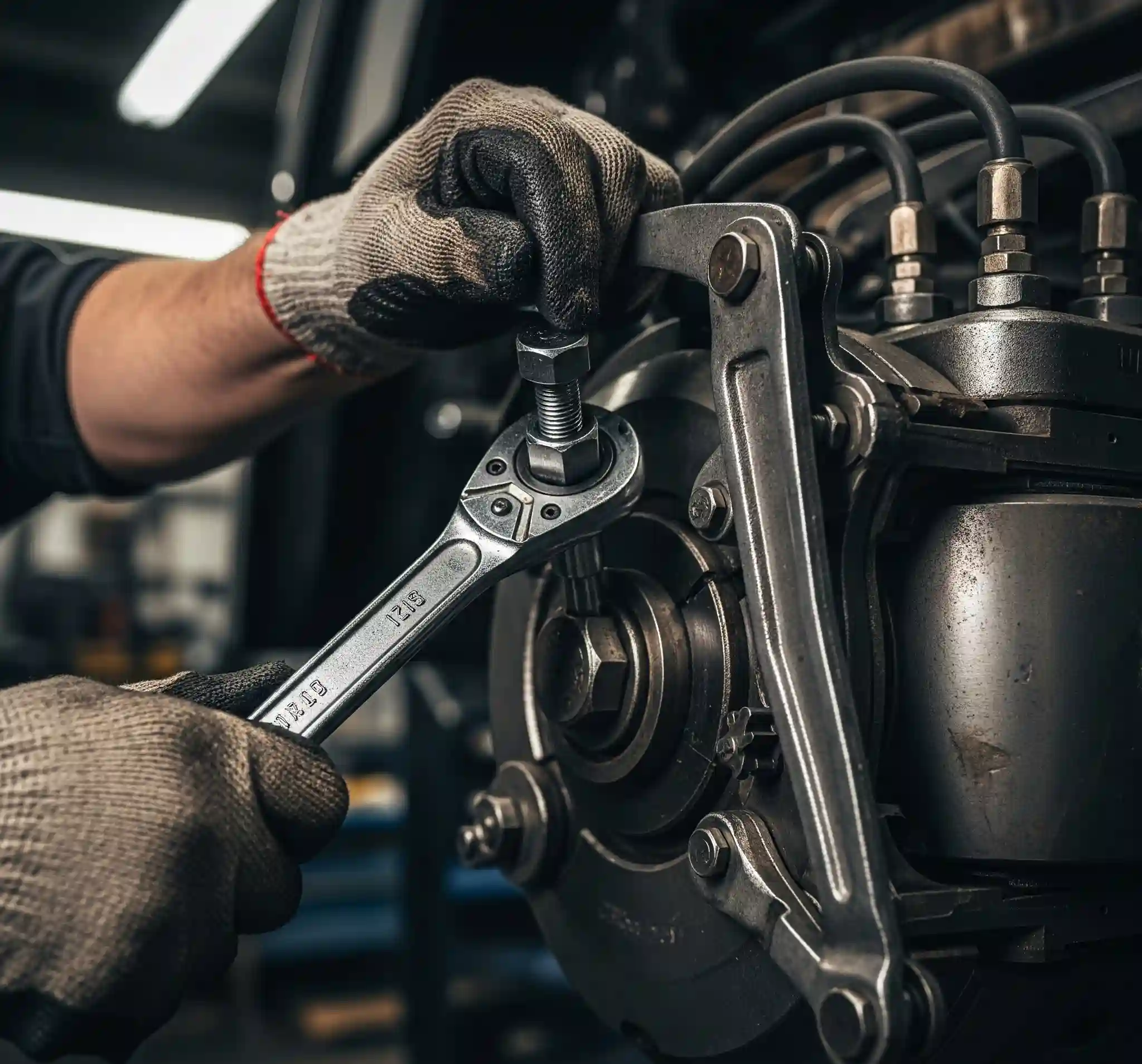
The Muscle of the Stop A Complete Guide to Truck Brake Chambers
When a 40-ton American truck needs to stop, it relies on a system of immense power and surprising simplicity. The iconic hiss of air is the sound of safety in action, but what is actually happening when a driver puts their foot on the pedal? The entire process of converting a simple push into thousands of pounds of stopping force comes down to one of the most critical and powerful components in the air brake system: the brake chamber.
At theamericantrucks.com, we know that understanding your rig is the key to keeping it safe and reliable. While the air compressor is the heart of the system, the brake chamber is its muscle. This guide will take a deep dive into this essential component, with a special focus on the workhorse of everyday braking: the Service Chamber. We’ll explore how it works, how it fails, and why its proper maintenance is non-negotiable for anyone on the road.
From Air Pressure to Mechanical Force
The fundamental job of a brake chamber is simple: to convert the potential energy of compressed air into the kinetic energy of mechanical force. It’s the final link in the chain of command that starts at the driver’s foot. Here’s the sequence:
- The driver presses the foot valve (brake pedal).
- The valve releases a measured amount of compressed air from the tanks.
- This air travels instantly through the lines to the brake chamber at each wheel end.
- The air pressure acts on the chamber, pushing out a steel rod.
- This pushrod turns the slack adjuster.
- The slack adjuster rotates an S-cam, which forces the brake shoes against the brake drum.
This powerful, instantaneous action is what brings the truck to a safe, controlled stop. The component responsible for this primary braking action is the Service Chamber.
Anatomy of a Modern Brake Chamber A Tale of Two Halves
If you look at the brake chamber on most modern trucks, you’ll notice it looks like two round canisters bolted together. This is because it’s actually two chambers combined into one unit, a design commonly called a “piggyback” or spring brake assembly. Each half has a distinct and vital job.
1. The Front Half The Service Chamber
This is the part of the assembly closest to the axle, and it is responsible for all normal, everyday braking. The Service Chamber is a relatively simple but powerful pneumatic actuator. Its key parts are:
- Housing (or Can): A stamped steel or aluminum housing that contains the other components.
- Rubber Diaphragm: A tough, flexible disc of reinforced rubber. This is the heart of the Service Chamber.
- Pressure Cap: The section where the air line connects. It directs air pressure onto the diaphragm.
- Pushrod and Return Spring: The steel rod that extends out of the chamber to apply the brakes, and a spring that retracts it when the air pressure is released.
When you apply the brakes, compressed air fills the pressure cap and pushes against the diaphragm. The force of this air pushes the diaphragm forward, which in turn moves the pushrod out of the chamber, applying the brakes. When you release the pedal, the air is exhausted, and the return spring pulls the pushrod and diaphragm back to their resting position. Every time you touch your service brakes, it’s the Service Chambers on your truck that are doing the work.
2. The Rear Half The Emergency / Parking Brake
The larger, rear half of the assembly contains an incredibly powerful coil spring. This is the system’s fail-safe. The spring is held in a compressed, caged position by a constant supply of air pressure (typically around 60 PSI or more) whenever the truck is in motion.
- For Parking: When the driver pulls the yellow parking brake knob, the air is released from this chamber. With no air to hold it back, the massive spring expands, mechanically forcing the pushrod out and applying the brakes.
- For Emergencies: If the truck were to suffer a catastrophic loss of air pressure, this chamber would automatically activate as the pressure drops, bringing the vehicle to a stop.
A Deeper Dive into Service Chambers
Since Service Chambers are used thousands of times on any given trip, understanding their specifics is key to maintenance and performance.
- Understanding “Type” Sizing: Brake chambers are identified by a “Type” number, such as Type 24, Type 30, or Type 36. This number isn’t arbitrary; it corresponds to the effective surface area of the rubber diaphragm inside, in square inches. For example, a Type 30 Service Chamber has a diaphragm with approximately 30 square inches of surface area. This is important because it determines the output force. At 100 PSI of air pressure, a Type 30 chamber will produce roughly 3,000 pounds of force (30 sq. in. x 100 PSI). Using the wrong size chamber will lead to a dangerous brake imbalance.
- Standard vs. Long-Stroke Chambers: The “stroke” is the distance the pushrod can travel. As brake shoes wear, the pushrod has to travel further to make contact. A long-stroke chamber provides an extra margin of travel (typically 2.5 inches vs. 2.0 inches for a standard Type 30), which offers a greater safety buffer against brakes going out of adjustment. Long-stroke chambers are often identifiable by a square air inlet port or special markings on the housing.
Common Failures and How to Spot Them
The constant work of the Service Chamber eventually takes its toll. Being able to spot the signs of failure is a critical skill for any driver.
- Ruptured Diaphragm: This is the most common failure. The rubber diaphragm can develop a tear from age and millions of flex cycles. The primary symptom is a loud, continuous hissing sound from the chamber only when the brakes are applied. This leak means a significant loss of braking force at that wheel.
- Internal Corrosion: If the truck’s air dryer is not working properly, moisture can get into the air lines. This water can cause rust to form inside the Service Chamber, which can damage the diaphragm or cause the pushrod to stick.
- Leaking Clamps: The clamp that holds the two halves of the chamber together can become loose or corroded, creating an air leak.
- Bent Pushrod: A bent pushrod can be caused by an improperly installed or malfunctioning slack adjuster, preventing the chamber from operating smoothly.
The Dangers of a Failing Chamber
A failing brake chamber is not a maintenance item to be deferred. It is an immediate safety risk.
- Increased Stopping Distance: A leaking Service Chamber cannot produce its full rated force. This means longer stopping distances, especially during a hard brake application.
- Brake Imbalance: If the chamber on one side of an axle is weaker than the other, the truck can pull sharply to the side with the stronger brake, potentially leading to a loss of control.
Maintenance is Not Optional
Proper inspection is the key to catching a problem before it becomes a disaster.
- The Applied Pressure Test: During a pre-trip inspection, have a helper apply the brakes (or use a brake pedal depressor) while you walk around the truck. Listen carefully at each wheel for the distinct hiss of a leaking Service Chamber diaphragm.
- Check Pushrod Travel: The single most important brake maintenance check is ensuring the brakes are in proper adjustment. If the pushrod has to travel too far (typically more than 2 inches on a Type 30 chamber), the chamber loses its effectiveness. This is a sign that the slack adjuster needs attention.
- Visual Inspection: Look for loose or missing clamps, cracked or damaged housings, and any signs of a bent pushrod.
When it comes time for replacement, quality is paramount. A high-quality replacement Service Chamber will feature a durable, multi-layer diaphragm, a powerful return spring, and a housing coated to resist corrosion. Investing in a dependable part is an investment in your safety.
In conclusion, the brake chamber is the unglamorous but essential muscle that brings your rig to a halt. The constant, reliable performance of your Service Chambers is a direct reflection of your commitment to safety. Through diligent inspection and the use of quality replacement parts, you ensure that every time you press that pedal, the power is there to keep you, your cargo, and everyone else on the road safe.
You can visit our website for more information.




